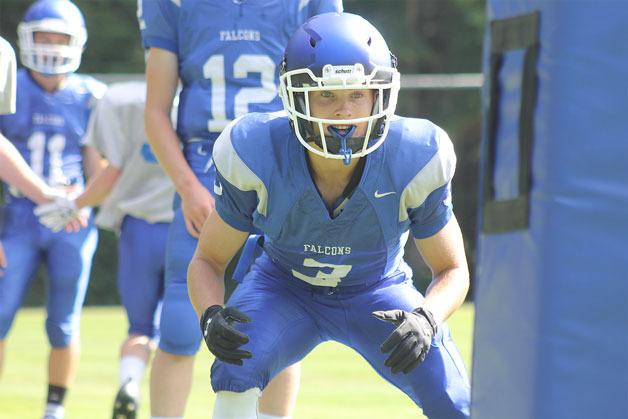Standing at 5 feet, 6 inches, South Whidbey football senior Connor Antich is already pretty close to the ground. He’ll be even lower this season.
As a response to a high volume of injuries last season, as well as a new directive by the Washington Interscholastic Athletics Association (WIAA), the Falcons are implementing safer tackling techniques that will limit the number of concussions sustained on the field. The emphasis will be on lowering the point of attack on a ball carrier and wrapping up around the legs or chest, while taking the head out of the tackle. It’s the same technique used by the Seattle Seahawks and one that coaches and players believe will go a long way to keep players healthy, while maintaining a high level of physicality.
“Basically, we’re going back to old school tackling, back in the days where there were no helmets,” said assistant head coach Shane Thrasher. “You tackle with your shoulders. You’re taking the head out of the play.”
“Your helmet is intended to be a safety device, not a weapon.”
Out of the dozen-plus injuries the Falcons suffered last season, Thrasher estimated that around 10 were concussions.
South Whidbey High School Athletic Director Paul Lagerstedt said that while football is an injury sport, his first concern is player safety. Though the number of injuries in a given year fluctuate, the high volume of head injuries prompted action to be taken, he said.
The technique, championed by USA Football, all begins with a defender keeping their eyes at chest level, Thrasher said. Players then break down into a starting foundation, chop their feet to gain balance and use the front of their shoulder as the point of contact. The player then opens his hips to generate power and create an ascending tackle. Finally, with the head to the side and away from contact, a defender throws double uppercuts on the back of the jersey and finishes the tackle.
During a drill on Aug. 18, players had to identify the number of fingers held up by another player standing in front of them before making their attack. By keeping their eyes up, the athletes will see where they are tackling and where to exert their strength.
“You still have the same amount of power using your shoulders as you did using your helmet,” Thrasher said. “You’re not losing any of your power in your tackle; you’re still driving the player to the ground.”
Thrasher, who is also the player safety coach, will keep a close eye on the Falcons as they learn the new technique during the first few weeks of practice. He was certified for the position after attending a Heads Up Football coaches’ clinic hosted by USA Football this past spring. Thrasher said the Falcons will have a new concussion protocol in place which involves a more rigorous evaluation before players are allowed back on the field.
“No more of this show up on a Thursday night with a doctor’s note that says, ‘I’m clear to play,’ and then play on Friday,” Thrasher said. “It’s a minimum of two weeks.”
“I won’t sign them off unless I know they’re physically ready to go back on the field and play at a safe level,” he added.
Antich, a defensive back, was among those who sustained a concussion. During the Falcons’ final game against Nooksack Valley last season, Antich had his bell rung after tackling a ball carrier.
“I think I just got a knee to the head,” Antich said. “I went lights out for probably 15 or 20 minutes and then I was back.”
Antich said some injuries in football are unavoidable, and that the concussion was the first of his career. He does believe, however, that the rugby style tackling technique will lessen the chance for that type of collision.
“In that case, I came in low maybe with my head in a little bit,” Antich said. “I know in my past, my coaches have said, ‘Go earhole someone.’ There’s no more of that talk. It’s all shoulders, still hitting hard.”
Chase Barthlett, a senior defensive lineman, said he prefers the new technique over the old.
“I feel like it is even more aggressive too, just because of how you can hit them and how you can roll with it,” Barthlett said.
As one of the most ferocious hitters on the team last season, Antich will be among those using the new technique the most. He said it won’t hinder his ability to stay aggressive and physical on defense.
“I’m just going to try use my shoulders more, but still stay as low as possible,” Antich said.


